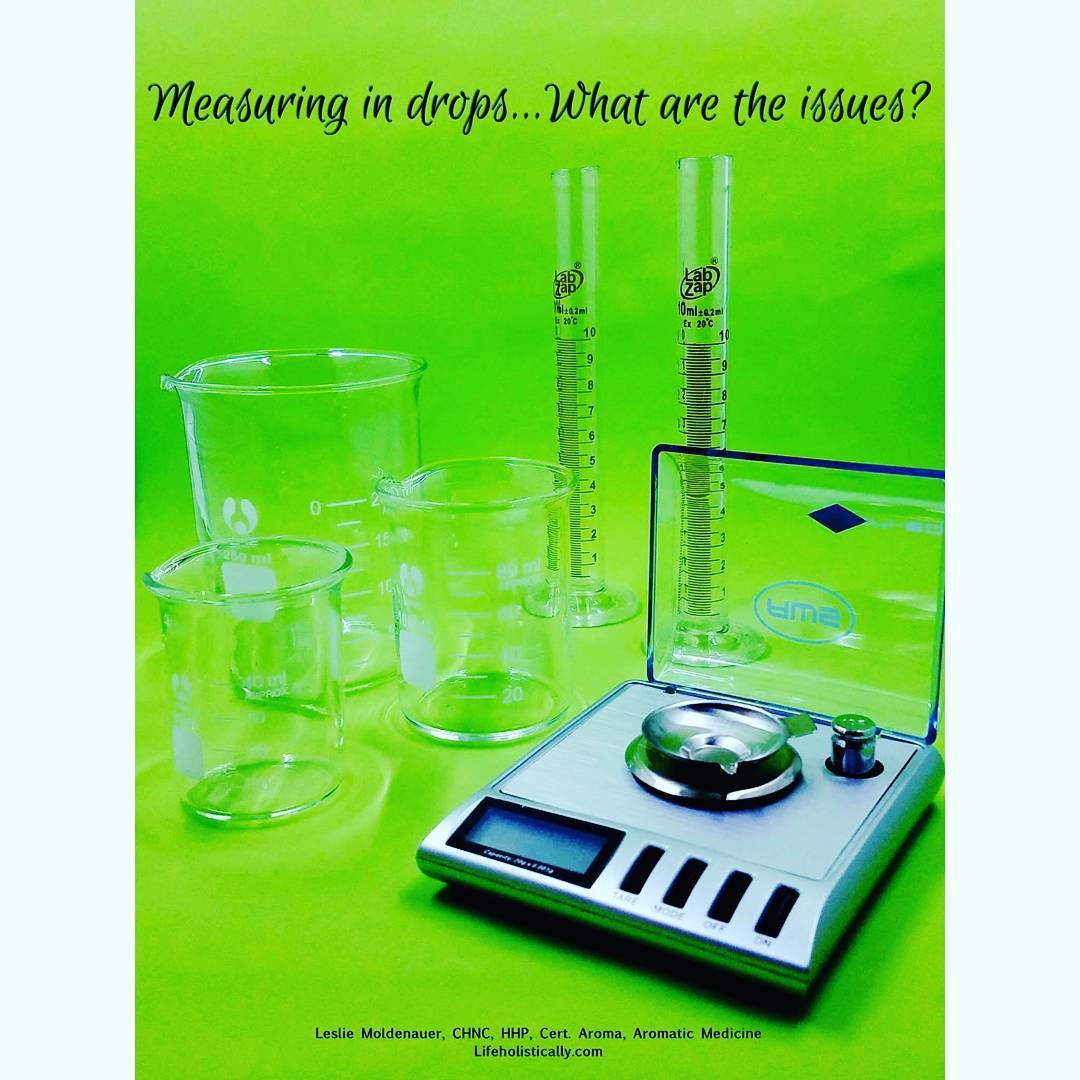There is often much discussion over the best way to measure essential oils when formulating. The quickest way may not be the most accurate way, for a number of reasons. Which way is this? Measuring drops directly from the essential oil bottle. This is the way that aromatherapy is initially taught, but perhaps it is time to look at the accuracy of this method, and other more accurate options that are available to us. Measuring by drops, what are the issues?
1. Not all essential oils are the same. What I mean by this is density. Density is defined as its mass per unit volume. Viscosity plays a part too as viscosity dictates how fast or slow an oil will pour from the orifice reducer, which can alter drop size. So therefore, you guessed it, even the temperature of your oils plays a role! Read more on density and viscosity here.
Because of these factors, it may or may not surprise you to hear that how many drops in 1ml can vary quite a lot; by as much as 20 drops or more. With some oils, some companies, some drippers, 1ml is equal to 20 drops of essential oils, while some are 40 drops (some go below and above these figures). Accuracy is sketchy at best due to a whole host of factors.
2. Size of the orifice reducer. This is a sensitive topic for some, but even the orifice reducer can play a part with how much oil comes out. There are non-vented drippers, vented drippers, euro drippers, etc. Not all orifice reducers are the same; you may have already discovered that some control the flow of oil better than others. The vented drippers have a method to their “madness” as well. For thicker oils it is said to pour with the vent hole down, and thinner oils with the vent hole facing up. Accuracy gets even trickier when even which way you tilt the bottle effects what comes out!
3. Want to replicate your formulation? If you have used drops directly from a reducer…good luck! I speak from experience when I first began making product some ten years ago. Signature aromas will be difficult to replicate.
4. Skin sensitization and maximum dermal ratios. Here are two instances that you should avoid pouring from a bottle at all costs if the product is for topical use. There are a number of oils such as Bergamot Citrus Bergamia, Cinnamon Bark Cinnamomum Zeylanicum, Lemon Citrus Limon, Lemongrass Cymbopogon Citratus, and Rose Otto Rosa Damascena to name just a few that have very specific dermal limits for our safety. Refer to Robert Tisserand’s Essential Oil Safety 2e to learn which essential oils carry a higher risk.
Measuring in these instances is going to be extremely challenging, but staying at or under the ratios is very important for your safety.
5. Here are pieces of two popular resources for drops charts with the community. I will be keeping the names anonymous, as that is not the important piece of sharing this information:
30ml-1%-9 drops
30ml-1%-6 drops
This does not necessarily mean too much if we are making an inhaler or placing oils in a diffuser…however how about topical use for a baby/child, pregnant mom, elderly, or immune compromised?
*Drops charts represent an average and are not a precise measurement tool. (They are a “recommendation”)
*Speak to a qualified aromatherapist for assistance if you are unsure.
6. I began to see measurements in a completely different light when I took my advanced aromatic medicine training. My brain was rewired if you will, and I saw the importance of weighing and/or measuring not only your essential oils but also your excipient. Yes, internal dosing is very different from formulating a lotion or a wound gel, however, they both have significant importance.
So, what are our options?
Measure by volume
Graduated cylinders are very helpful when you want to measure in mls. If you make a product for others, or you have synergies that you use more than once, you can make what is called a master blend and measure in mls. This ensures accuracy in your formulations. Store your master blends in the fridge and use whenever needed.
Measuring by weight
Lower end Mg scales are incredibly inexpensive, accurate, and quite fun to use! Measuring in mg or g is hands down the most effective and accurate way to measure your essential oils. A $20-$30 scale is all the new user of scales will need, but of course, they also vary in price..you can spend quite a bit more.
Closing
There will absolutely be times that you measure by drops. Making a one-time blend? Throwing together an inhaler? Making a synergy to slip into the bath at the last minute? Have to work quickly to reduce pain or the effects of a bruise that is about to show itself? There are many, many instances where measuring by drops will happen, and this article is not to say NO NEVER (as we all know I do not practice in this way).
I wanted to point out the inconsistencies that can happen with charts, give options to get clear accuracy every single time and have fun while you create. If I am formulating on a larger scale, I use a graduated cylinder or mg scale. If you enjoy blending now, wait until you start playing with these tools! Don’t say I didn’t warn you!

BEFORE YOU GO! Remember to sign up for my FREE Facebook group! Hang out with me and THOUSANDS of other Essential Oil lovers looking to learn, click on to join Real Essential Oil Education Group!
Check out my FREE offer below!

Like so many practices in life I encourage you to become educated on the proper use of essential oils. When using them, please do so cautiously, understanding that there is often misinformation on the internet. You can be assured that I support only educated and proven resources. While essential oils should not be feared they should be respected and used properly to ensure the safety of the individuals using them.
Please note that I am not a medical practitioner. The content of this website is provided for general informational purposes only and is not intended as, nor should it be considered a substitute for, professional medical advice. Do not use the information on this website for diagnosing or treating any medical or health condition. If you have or suspect you have a medical problem, promptly contact your professional healthcare provider. By using this website, you assume full responsibility and liability for your own actions.
[mailpoet_form id=”2″]




